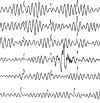Links to related sites are found at the bottom of this page.
![]() Timing
marks are 1 minute (60 seconds) apart - but the motor is malfunctioning, so time
measurements based on proportional distance are not accurate to plus or
minus 1 second (if the motor were running properly, the first arrival could be timed to an
accuracy of 0.1 second). The minute begins where the minute mark begins its
"upstroke". Time correction = -2.4 seconds.
Timing
marks are 1 minute (60 seconds) apart - but the motor is malfunctioning, so time
measurements based on proportional distance are not accurate to plus or
minus 1 second (if the motor were running properly, the first arrival could be timed to an
accuracy of 0.1 second). The minute begins where the minute mark begins its
"upstroke". Time correction = -2.4 seconds.
The she ar wave is
clipped - ground motion was too much for our poor needle. It is interesting to note
that this event was recorded as an interesting pulse on our highly uncalibrated LPZ
instrument. LPZ instruments usually do not respond to earthquakes this small.
If you are not an experienced seismogram reader, you might not recognize that most of the
wiggles shown are microseisms (ground roll associated with strong weather systems far away
- hurricane Georges?) and that the wiggle on the fourth line from the top on this image,
between the second and third minute marks (3:54 and 3:55 EDT respectively), is the
long-period ground motion due to the earthquake.
ar wave is
clipped - ground motion was too much for our poor needle. It is interesting to note
that this event was recorded as an interesting pulse on our highly uncalibrated LPZ
instrument. LPZ instruments usually do not respond to earthquakes this small.
If you are not an experienced seismogram reader, you might not recognize that most of the
wiggles shown are microseisms (ground roll associated with strong weather systems far away
- hurricane Georges?) and that the wiggle on the fourth line from the top on this image,
between the second and third minute marks (3:54 and 3:55 EDT respectively), is the
long-period ground motion due to the earthquake.
So - did people in Toledo feel the shear ("S") wave, or the Rayleigh wave (ground roll) - a kind of surface wave? Was the motion you sensed more north-south or more east-west, and, which direction from the earthquake were you when the ground moved? Most people I spoke with thought the motion was east-west, consistent with Rayleigh wave motion from a source to the east. Shear wave motion would have some east-west horizontal motion ("SV") but more of the shear wave motion should be north-south, at right angles to a wave propagating from east to west. In addition, body waves decrease in amplitude as a function of inverse distance (1/R), whilc surface wave amplitude decreases proportional to the square root of inverse distance (1/SQRT(R)).
Corrections as posted 10 AM EDT, 9/28/98 and again at 1520 EDT, 10/12/98.
First P-wave arrival at 19:53:23.9 GMT on 9/25/98 (after time correction is applied). I'd not wager on this being accurate to within 1 second, but doubt that it is now more than 2 seconds off. Station coordinates and elevation are listed on the UTO Home Page. Our WWV antenna needs adjustment, so our clock is not synchronized as frequently as we should.
I measure an S-P interval of between 42.8 and 44.5 seconds seconds (shear wave arrivals are always a bit ambiguous on vertical instruments). Because the motor malfunction stops the drum rotation for short intervals, this is the maximum S-P time because it assumes the drum ran constantly during this interval.
My initial measurement (made with a television reporter taping everything), as reported last Friday, was wrong. I forgot to correct the reading for the slow motor. Also, my e-mail was down from the morning of 9/25 through noon on 9/29. I was not ignoring your messages, I was simply not able to receive them.
Dr. D. Stierman
Return to UTO College of Wooster's seismogram PEPP station index
Ohio Department of Natural Resources tracks field studies
MichSeis: our friends in Ann Arbor THE AFTERSHOCK!!
earthquake fans since a hacker reset our hit counters on
11-13-98.